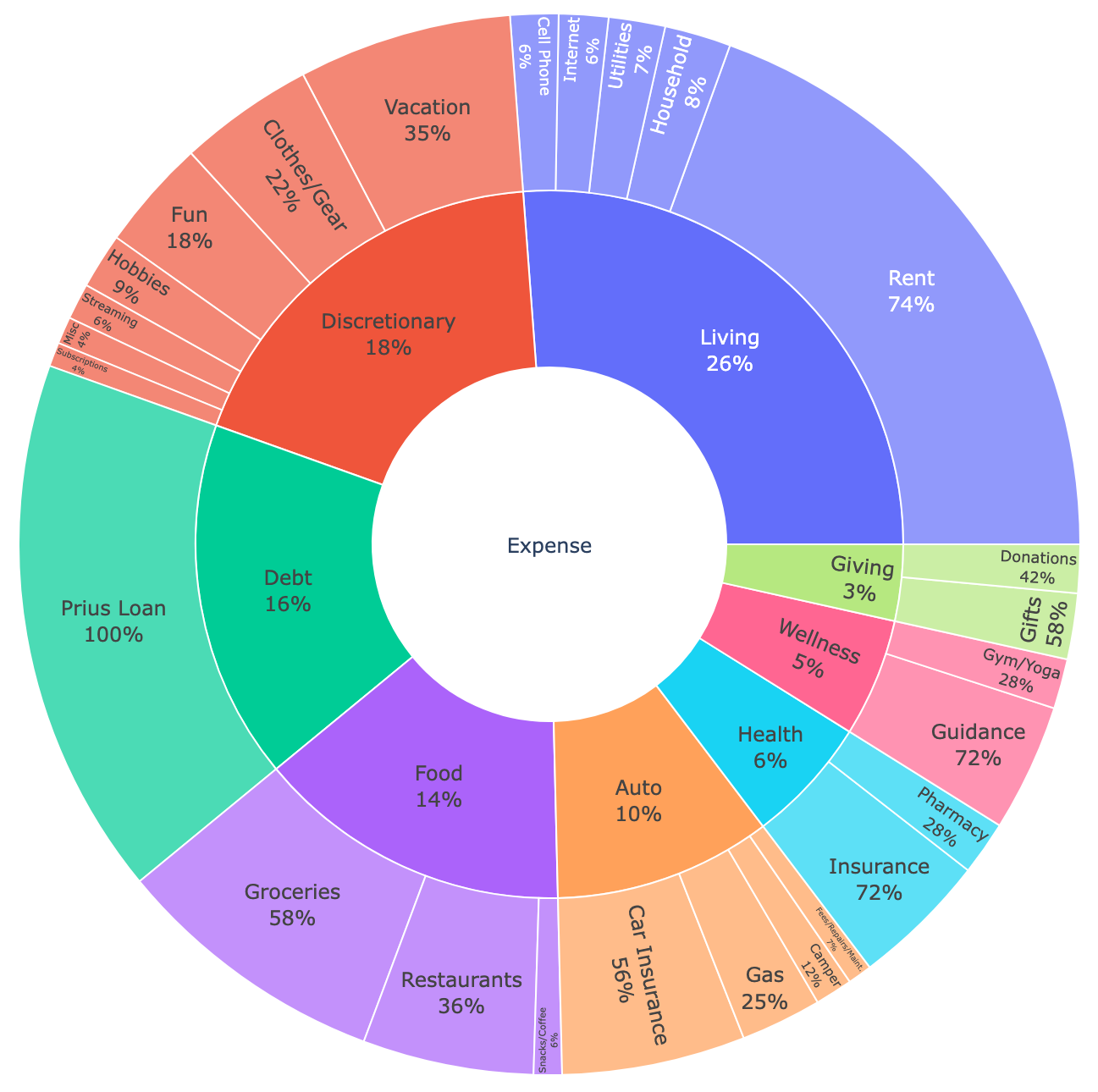Visualizing Financial Data with DuckDB And Plotly
I like to keep a pretty close eye on my finances, such as my spending habits and net worth. Over the years, I’ve used a lot of different tools, such as YNAB, Mint and Quicken.
These days, I really like the spreadsheet based tool Tiller (note: affiliate link). With Tiller, all of my financial data lives in a spreadsheet that I control (in Google Sheets).
The visualizations that come with Tiller are incredible (both official and community), but a huge benefit is having all of my data available as a spreadsheet. I can export the data as CSVs and then run whatever tools I want.
I also recently learned about Plotly, a great graphing library for Python. Combine that with my love of DuckDB for querying data1, and I have found new ways to visualize my financial data.
For example, below is a sunburst diagram visualizing expenses. An interactive version is available at plotly_expenses.html.

(For these examples, I’m using this sample Tiller sheet from this community post.)
In the sections below, I’ll walk through how I generated this diagram.
Querying Tiller Data with DuckDB
First, I exported the Transactions and Categories tabs from the Tiller Sheet. Transactions is a list of every ingested transaction with an assigned category. The Categories tab adds a hierarchy to the set of categories, such as Groceries and Restaurants belonging to the Food group of expenses.
Then, I used DuckDB to query these sheets in Python. For example, here’s a sum of expenses by group and category:
expenses_by_category = duckdb.sql(
"""
select
c.Type,
c.Group,
t.Category,
-round(sum(replace(replace(t.Amount, '$', ''), ',', '')::decimal), 1) as Amount
from read_csv('Tiller Sample Data - Transactions.csv') t
join read_csv('Tiller Sample Data - Categories.csv') c on c.Category = t.Category
and c."Hide From Reports" is null
and c.Type = 'Expense'
group by t.Category, c.Group, C.Type
"""
)
expenses_by_category.show()
Which prints:
┌─────────┬───────────────┬─────────────────────┬───────────────┐
│ Type │ Group │ Category │ Amount │
│ varchar │ varchar │ varchar │ decimal(38,1) │
├─────────┼───────────────┼─────────────────────┼───────────────┤
│ Expense │ Discretionary │ Clothes/Gear │ 8612.5 │
│ Expense │ Wellness │ Guidance │ 8131.8 │
│ Expense │ Food │ Snacks/Coffee │ 1796.6 │
│ Expense │ Auto │ Camper │ 2392.8 │
│ Expense │ Discretionary │ Subscriptions │ 1540.0 │
│ Expense │ Food │ Groceries │ 17483.5 │
│ Expense │ Living │ Household │ 4231.0 │
│ Expense │ Health │ Pharmacy │ 3437.9 │
│ Expense │ Discretionary │ Streaming │ 2303.0 │
│ Expense │ Wellness │ Gym/Yoga │ 3171.9 │
│ · │ · │ · │ · │
│ · │ · │ · │ · │
│ · │ · │ · │ · │
│ Expense │ Food │ Restaurants │ 10897.4 │
│ Expense │ Auto │ Fees/Repairs/Maint. │ 1549.1 │
│ Expense │ Discretionary │ Hobbies │ 3538.9 │
│ Expense │ Living │ Cell Phone │ 3060.0 │
│ Expense │ Giving │ Donations │ 3086.4 │
│ Expense │ Living │ Utilities │ 3600.0 │
│ Expense │ Living │ Rent │ 40727.9 │
│ Expense │ Discretionary │ Fun │ 7076.9 │
│ Expense │ Living │ Internet │ 3150.0 │
│ Expense │ Auto │ Car Insurance │ 11682.0 │
├─────────┴───────────────┴─────────────────────┴───────────────┤
│ 26 rows (20 shown) 4 columns │
└───────────────────────────────────────────────────────────────┘
The only tricky part was cleaning up the Amount field so DuckDB treated it as a number. There may be a simpler way to do that.
Graphing with Plotly
Once I had the tabular data from DuckDB, graphing it with Plotly was simple. Plotly can generate an image file, but I think it really shines when generating standalone, interactive HTML:
expenses_by_category_sunburst = px.sunburst(
expenses_by_category,
path=["Type", "Group", "Category"],
values="Amount",
)
expenses_by_category_sunburst.update_traces(textinfo="label+percent parent")
expenses_by_category_sunburst.write_image("expenses_sunburst.png")
expenses_by_category_sunburst.write_html("plotly_expenses.html")
Full script
I use uv these days for managing Python dependencies, which lets you embed the dependency requirements as a comment in the Python script. So you can save this as tiller_plotly.py and then run it with uv run tiller_plotly.py, which will automatically download the dependencies:
# /// script
# requires-python = ">=3.12"
# dependencies = [
# "duckdb~=1.2",
# "kaleido~=0.2", # Needed to generate images
# "plotly[express]~=6.0",
# "pyarrow~=19.0",
# ]
# ///
import duckdb
import plotly.express as px
expenses_by_category = duckdb.sql(
"""
select
c.Type,
c.Group,
t.Category,
-round(sum(replace(replace(t.Amount, '$', ''), ',', '')::decimal), 1) as Amount
from read_csv('Tiller Sample Data - Transactions.csv') t
join read_csv('Tiller Sample Data - Categories.csv') c on c.Category = t.Category
and c."Hide From Reports" is null
and c.Type = 'Expense'
group by t.Category, c.Group, C.Type
"""
)
expenses_by_category.show()
expenses_by_category_sunburst = px.sunburst(
expenses_by_category,
path=["Type", "Group", "Category"],
values="Amount",
)
expenses_by_category_sunburst.update_traces(textinfo="label+percent parent")
expenses_by_category_sunburst.write_image("expenses_sunburst.png")
expenses_by_category_sunburst.write_html("plotly_expenses.html")
And if you want to try out Tiller, check it out here: Tiller (affiliate link)
-
Other DuckDB posts I’ve written: DuckDB as the New jq and DuckDB over Pandas/Polars ↩